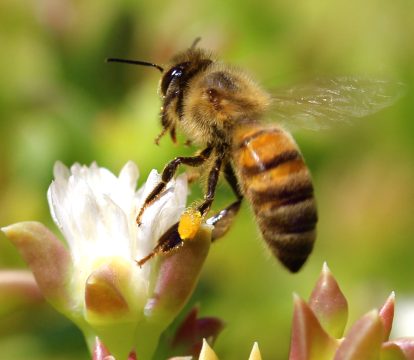12
Dec
Scientific Literature Review Again Identifies Pesticide Disruption of Bee Gut Microbiota

(Beyond Pesticides, December 12, 2023) A review published in Nature Reviews Microbiology finds pesticides can disrupt honeybee (Apis mellifera) microbiota (bacteria) in their gut, altering the immune system, metabolism, behavior, and development. Many studies emphasize chemical-driven agricultural systems dependent upon pollinators and products that harm or kill off these sensitive species. Previous studies have linked adverse impacts to bee microbiome to pesticide exposure. Toxic (manufactured poison) pesticides readily contaminate the ecosystem with residues pervasive in food and water commodities. In addition to this study, the scientific literature commonly associates pesticides with human, biotic, and ecosystem harm, as a doubling of toxic effects on invertebrates, like pollinators, has been recorded since 2004.Â
Pollinator declines directly affect the environment, society, and the economy. Many agricultural and nonagricultural plant species will decline or cease to exist without pollinators. In turn, the economy will take a hit, since much of the economy (65%) depends upon the strength of the agricultural sector. As the science shows, pesticides are one of the most significant stressors for pollinators. Additionally, pesticides have a devastating impact on bees and other pollinators and the larger context of what has been called by scientists as the “insect apocalypse.” In a world where habitat loss and fragmentation show no sign of abating, scientists have concluded that the globe cannot afford to subject its critically important wild insects to these combined threats. Therefore, studies like these emphasize the need for improved assessment of environmentally relevant chemical exposure levels to honey bees.
The review explores the relationship between microbiota in the gut of bees and the effects on bees’ health and biological function: microbial interactions within the stomach, processes in bee biology and health, impact of agricultural practices, and potential for probiotics in bees (which remains unclear). Since bacteria in the bees’ gut occupy differing niches, their interaction with the host and each other can vary. Gut microbiota protects against pathogens and parasites, processes dietary or bodily components, and interacts with species within the host. Decreased microbial abundance and diversity can negatively affect honey bee health and survival. Without these microbiota, gene expression (a gene relaying information to produce a function) can change, weakening immune response, metabolic process, and development. Additionally, antibiotic exposure is a concern among agricultural exposure as antibiotic treatments lessen microbial abundance in the gut, hampering the absorption of nutrients, weight gain, immunity, and development of bee larvae.
The intestines host a group of microorganisms (microbiota) that form the gut microbiome. Gut microbiota, including bacteria, archaea, viruses, and fungi, play a crucial role in regulating lifelong digestion, immune, and central nervous system. Ample evidence demonstrates environmental contaminants like pesticides negatively affect gut microbes. Through the gut microbiome, pesticide exposure can enhance or exacerbate the adverse effects of additional environmental toxicants on the body. Since the gut microbiome shapes metabolism, it can mediate some toxic effects of environmental chemicals. However, with prolonged exposure to various environmental contaminants, critical chemical-induced changes may occur in the gut microbes, influencing adverse health outcomes. However, honey bees are not the only insects facing harm from environmental contaminants like pesticides, as all pollinators are in peril from exposure to environmental pollutants.
Like gut microbes, soil microbes are essential for the standard functionality of the soil ecosystem. Toxic chemicals damage the soil microbiota by decreasing and altering microbial biomass and soil microbiome composition (diversity). Pesticide use contaminates soil and results in a bacteria-dominant ecosystem as these chemicals cause “vacant ecological niches, so rare organisms become abundant and vice versa.” The bacteria outcompete beneficial fungi, which improves soil productivity and increases carbon sequestration capacity. The resulting soil ecosystem is unhealthy and imbalanced, with a reduction in the natural cycling of nutrients and resilience. Thus, plants grown in such conditions are more vulnerable to parasites and pathogens.Â
Like previous literature cited above, this review shows that pesticide use can disturb and shift the abundance of specific microbes in the bee gut microbiome. Pesticide-induced disturbances occur primarily in one of two ways—either directly harming microbes or indirectly harming the host’s (bee) health and subsequently shifting the microbiome. An unfavorable environment produced by the bee’s gut can create an environment less suitable for certain microbes. Moreover, regarding the impacts of exposure, the duration of pesticide exposure is more important than the amount of pesticide to which a bee is exposed. Longer exposure times result in more significant disturbances but likely vary by pesticide mode of action. A 2018 study found that it disrupts honey bee microbiota, and a 2015 study found that it results in sublethal effects on honey bee navigation and foraging success. However, studies suggest inerts may play a role in pollinator harm.
Three out of four food crops globally depend on pollinators, and honey bees account for a significant portion of pollination of some U.S. crops. To protect honey bees and other pollinators, check out what you can do by using pollinator-friendly landscapes and pollinator-friendly seeds, engaging in organic gardening and landscaping, and supporting organic agriculture through purchasing decisions. Learn more about the science and resources behind the adverse effects of pesticides on pollinators and take action against the use of pesticides. Buying, growing, and supporting organic will help eliminate the extensive use of pesticides in the environment. Organic land management and regenerative organic agriculture eliminate the need for toxic agricultural pesticides. For more information on the organic choice, see the Beyond Pesticides webpages, Health Benefits of Organic Agriculture, Lawns and Landscapes, and Parks for a Sustainable Future.Â
All unattributed positions and opinions in this piece are those of Beyond Pesticides.
Source: Nature Reviews Microbiology










